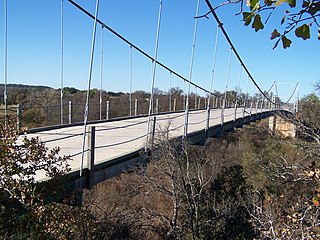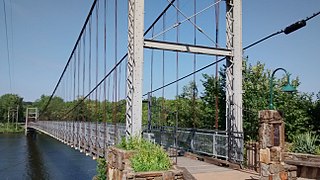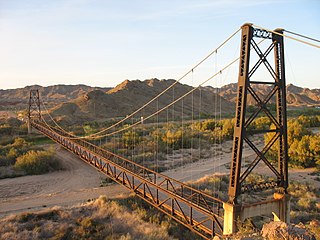
The Regency Bridge, locally known as the "Swinging Bridge," is a one-lane suspension bridge over the Colorado River in Texas. It is located at the intersection of Mills County Road 433 and San Saba County Road 137, both gravel roads, near a small community called Regency. The bridge spans the Colorado River between Mills and San Saba counties.

This is a list of properties and districts in Mississippi that are listed on the National Register of Historic Places. There are more than 1,400 sites distributed among all of Mississippi's 82 counties.

The Fort Madison Toll Bridge is a tolled, double-decked swinging truss bridge over the Mississippi River that connects Fort Madison, Iowa, and unincorporated Niota, Illinois. A double-track railway occupies the lower deck of the bridge, while two lanes of road traffic are carried on the upper deck. The bridge is about 1 mile (1.6 km) long with a swing span of 525 feet (160 m), and was the longest and largest double-deck swing-span bridge in the world when constructed in 1927. It replaced an inadequate combination roadway/single-track bridge completed in 1887. The main river crossing consists of four 270-foot (82 m) Baltimore through truss spans and a swing span made of two equal arms, 266 feet (81 m) long. In 1999, it was listed in the National Register of Historic Places under the title, Fort Madison Bridge, ID number 99001035. It was also documented as survey number IA-62 by the Historic American Engineering Record, archived at the Library of Congress. Construction and photographic details were recorded at the time in Scientific American magazine.

The Bollman Truss Railroad Bridge across the Little Patuxent River at Savage, Maryland, is one of the oldest standing iron railroad bridges in the United States and the sole surviving example of a revolutionary design in the history of American bridge engineering. The 160-foot (48.8 m) double-span was built in 1852 at an unknown location on the main line of the Baltimore and Ohio Railroad. It was moved 35 years later to its present location, where it replaced the very first Bollman bridge. Today, it carries the Savage Mill Trail.

The Androscoggin Swinging Bridge is a pedestrian suspension bridge spanning the Androscoggin River in Maine between the towns of Topsham in Sagadahoc County and Brunswick in Cumberland County. The bridge was built in 1892 as a timesaving approach for employees of the Cabot Manufacturing Company of Brunswick, could have safer and easier passage across the river.

Duck Run Cable Suspension Bridge, also known as Trubada Swinging Bridge, is a historic cable suspension bridge that spans the Little Kanawha River at Trubada, Gilmer County, West Virginia. The bridge was built in 1922. The bridge is 351 feet, 7 inches, with a main span of 209 feet, 9 inches, and two half spans of 76 feet, 6 inches, and 65 feet, 4 inches. It features four reinforced concrete towers for the two wire rope cables.

The Yosemite Valley Bridges are eight bridges in the Yosemite Valley of Yosemite National Park, most of them spanning the Merced River. Five of them were built in 1928, with the remainder built between 1921 and 1933. The bridges feature a concrete structure faced with local stone, in an elliptical or three-centred arch configuration. They are notable for their uniform character and for their conformance to tenets of the National Park Service rustic style. Design work for the seven newer bridges was by George D. Whittle of the San Francisco District Office of the U.S. Bureau of Public Roads for the National Park Service. Concrete bridges were chosen at the urging of Thomas Chalmers Vint of the Park Service, in lieu of alternative designs for steel truss bridges, or suspension bridges suggested by the park superintendent.

English Center Suspension Bridge is a historic suspension bridge spanning Little Pine Creek in Pine Township, Lycoming County, Pennsylvania. It was built in 1891 and has a single span measuring 300 feet (91 m) long and 15 feet (4.6 m) wide.

The Cameron Suspension Bridge crosses the Little Colorado River at Cameron, Arizona, United States.
The Coon Box Fork Bridge is a swinging suspension bridge located 1 mile (1.6 km) southwest of Coon Box in Jefferson County, Mississippi. The bridge carries Coon Box Road across the North Fork Coles Creek. Constructed in 1919 for $3,498.99, the bridge has a wooden deck and concrete towers plated in iron. The bridge was one of many of the same type constructed in Jefferson County in the early 1900s to serve farmers in Coon Box; it is considered a "highly successful technological product" and is in fair condition. The bridge was added to the National Register of Historic Places on May 23, 1979. The bridge was destroyed in 2015.

The Haggard Ford Swinging Bridge is a historic suspension bridge in Boone County, Arkansas. It is located adjacent to Cottonwood Road, about 8 miles (13 km) north of Harrison, and spans Bear Creek. It has cast-in-place concrete abutments, towers, and anchorages, and is supported by steel cables. A wooden deck, one travel lane in width, is suspended from steel hangers. The bridge is about 160 feet (49 m) long. The bridge was built 1938–41 with funding from the Works Progress Administration. Fill surrounding the abutments was washed away in 1945 and subsequently replaced. The bridge deck was replaced in 1977.
The Zinc Swinging Bridge is a pedestrian suspension bridge spanning Sugar Orchard Creek in the small town of Zinc, Arkansas, United States, that is listed on the National Register of Historic Places.

The Verde River Sheep Bridge, also known as the Red Point Sheep Bridge, is a suspension bridge which crosses the Verde River in Arizona. Constructed primarily to allow sheep to be driven between grazing ranges on either side of the river. Building started in 1943 and was completed in 1944. Sheep drives stopped in 1978. The bridge was closed in 1987 and largely demolished in 1988. A replica bridge was constructed by the U.S. Forest Service in 1989 to allow hikers access to the Mazatzal Wilderness in Tonto National Forest. The original west suspension tower still remains alongside the replica bridge.

The San Rafael Bridge is a historic suspension bridge over the San Rafael River in central Emery County, Utah, United States, that is listed on the National Register of Historic Places (NRHP).

Upper Bridge, also known as the Warsaw Swinging Bridge, is a historic cable suspension bridge located at Warsaw, Benton County, Missouri. It originally opened in 1904 and rebuilt in 1928 after a tornado in 1924. It measures 600 feet (180 m) long, and spans the Osage River. It has a 500-foot (150 m) span between steel towers.

Bridge 9 is a historic Parker through truss bridge, carrying Shawville Road across the Missisquoi River in Sheldon, Vermont. Built in 1928 after Vermont's devastating 1927 floods, it is one of the few surviving Parker truss bridges on the Missisquoi. It was listed on the National Register of Historic Places in 2007.

The Milford Suspension Bridge is a historic pedestrian bridge spanning the Souhegan River between Bridge and Souhegan Streets in Milford, New Hampshire. Built in 1889, it is the only surviving work of the Berlin Iron Bridge Company in the state, and one of a small number of surviving 19th-century suspension bridges. It was listed on the National Register of Historic Places in 2017.

The Station Road Bridge, near Brecksville, Ohio, was built in 1882. It spans the Cuyahoga River between Cuyahoga County and Summit County, Ohio. It was listed on the National Register of Historic Places in 1979.

The Waverly Bridge near Waverly, Mississippi is a railway swinging bridge spanning between Lowndes County, Mississippi and Clay County, Mississippi. It brings the Columbus and Greenville Railway across the Tombigbee River.

The McPhaul Suspension Bridge, sometimes known as Yuma, Arizona's Bridge to Nowhere, is a suspension bridge that used to carry a section of Arizona Route 95. The bridge is listed on the National Register of Historic Places. The bridge, which was named for local Yuma resident Henry Harrison McPhaul, was built over the Gila River in 1929 and replaced in 1968 when it was deemed insufficient for modern transportation needs. At only 16 feet wide, the bridge was too narrow for a US numbered highway. A dam and replacement bridge were built and the river was rerouted.



















